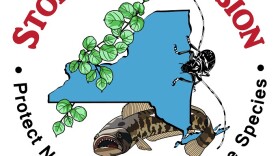Officials are alerting Massachusetts residents that they have found evidence of an invasive species known as the Spotted Lanternfly. There has been an outbreak of the bug – native to Asia – in Connecticut, Delaware, Maryland, New Jersey, New York, Pennsylvania, Virginia, and West Virginia. WAMC spoke with Jennifer Forman Orth – a biologist at the Massachusetts Department of Agricultural Resources – about the threat the Spotted Lanternfly poses to the state, and how it was accidentally introduced.
FORMAN ORTH: The risk is to anybody that received goods or materials from Pennsylvania, New Jersey, Virginia and New York or any of the other states that have known Spotted Lanternfly infestations, but also to anybody that might have gotten goods or materials from a company that imports materials from those states. And when I say goods and materials, I'm talking about everything from plants to lumber, building materials, outdoor furniture, really anything that a lantern fly can either hitchhike on or lay eggs on.
WAMC: Now, what does the fly do exactly that makes it a risk to Massachusetts agriculture?
So it is a sap-feeding insect, it has a very long proboscis. And it is basically like, acts like a straw. So it sticks the proboscis into any juicy part of a plant and sucks out all the sap. That's definitely bad for plants that it attacks. But at the same time that it's doing this, it's also excreting a waste material that they call honeydew, it's this sticky substance, that will start to coat the plants it's feeding on and then the honeydew starts to grow a fungus on it that can damage the plants. The reason why we're concerned about agriculture is that some of the plants that lanternfly is known to attack are grape vines, and maple trees, and hops and apple trees, peach trees. So basically a lot of important agricultural commodities in our state.
What are signs that the lanternfly might be present in someone's agricultural crop? Are there are things people can look out for beyond having ordered from companies that may have brought them to the state that would indicate that the flies are present?
Right now, adult spot and lanternflies are very active, they're at the stage where they're mating and laying eggs. So what people should be looking for are signs of the adult insect, which is a large gray insect about one inch long. It has black spots, and red underwings. And then folks should also be looking out for signs that they are laying eggs, and that would be inch-long rectangular, yellowish-brown egg masses that are covered with a gray waxy coating that kind of looks like putty.
Now let's say one finds proof or evidence of the lanternfly being present. How does one report that to the state?
Anybody that wants to report signs of spotted lanternfly, I would say the easiest way to do it is to go to Mass.gov and just search for the word "spotted lanternfly." It will bring you right to the front page.
What would the sort of escalation of this situation be? That it's a more widespread problem than it is already known to be? What's the sort of next level of concern on the state level?
The thing that we're most concerned about is that we want to prevent spotted lanternfly from becoming established in our state. So what we're really on the lookout for any signs that the insect has started an infestation somewhere. And as of right now, we've only found adult lanternflies. We have actually found some live records over the weekend based on the outreach that we were doing. So it's really great that we got the word out. And I'm happy that we're getting the opportunity to put even more information out in Western Mass, because it generated several new reports for us. But we still have not found any evidence of an infestation in Massachusetts, just you know, individual adult insects that were either alive or dead.
Is there anything else folks should know about the situation out here in Western Massachusetts? Obviously, a large agricultural community here, a big part of the economy.
I think it's important for people to know that the Mass Department of Agriculture is responding to all of these signs. We have surveys going on. We have traps that we're setting up at any location where we've confirmed signs of the pest. But the most important thing is that we really depend on reports from the public to alert us about any new fines, so I encourage everybody to take a few moments and check their trees for spotted lanternfly and to report any new finds to us.








